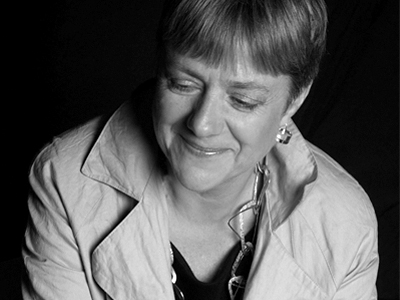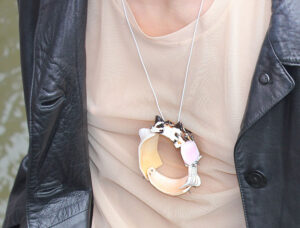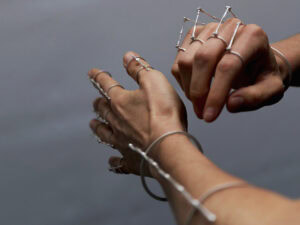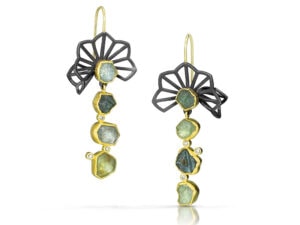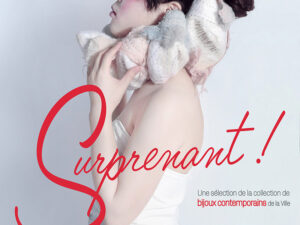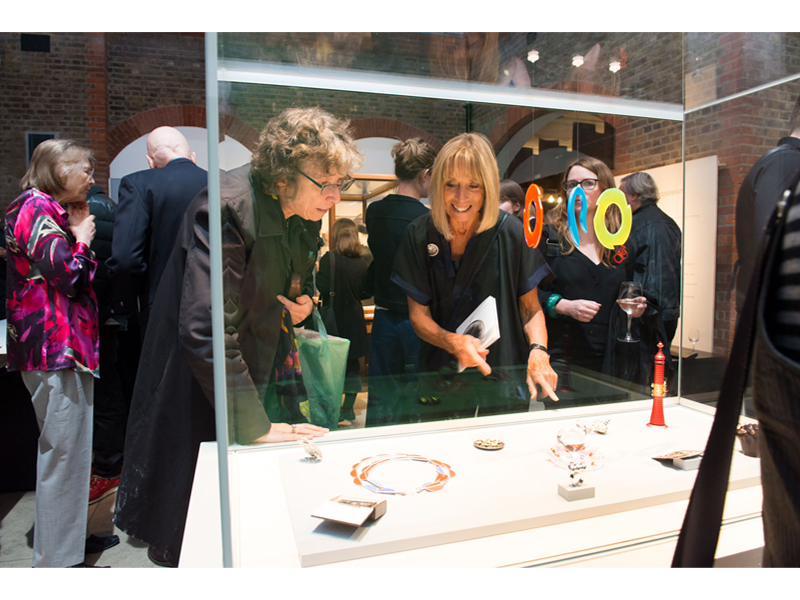
On January 3, 2016, Art Jewelry Forum published a review of A Sense of Jewellery, an exhibition of British work made over the last 50 years curated by Amanda Game and Professor Dorothy Hogg for the Goldsmiths’ Centre, London. The difficult location of the exhibition in the Centre’s foyer informed reviewer Stephen Knott’s first impressions. He lauded some aspects of the show, but faulted both its staid setup and the minimal captions and wall texts for failing to do justice to the dynamism of contemporary jewelry. His position, which favors more curatorial information to better understand the complex history of artistic and wearable objects, reflects an important trend in curatorial circles.
Co-curator Amanda Game is no newcomer to the challenging world of exhibition-making, and for this project, she advocated a less intrusive (and occasionally more interactive) form of knowledge transmission. That position also has strong supporters: It rejects heavy didactics—which often force-feed visitors with predigested interpretations—usually in favor of different strategies for viewer engagement.
AJF is interested in publishing her response to Stephen Knott’s review because it illustrates the importance of curatorial strategy in shaping our perception of exhibits. Every strategy is a choice, which might fail to convince every viewer. But their curatorial expectations are not the only thing that divides them: Amanda Game also found that Stephen Knott’s review missed important aspects of the project, and felt it useful to provide AJF readers “a more accurate picture of the show’s ‘working economy.’”
-Benjamin Lignel
In a curious way Stephen Knott understood one critical element of this show well, despite his lukewarm review, although he only revealed this indirectly through his choice of words. As he says in the opening section of his comments on A Sense of Jewellery: “the text plays second fiddle to the objects.”
It was indeed the curatorial intention to give these 45 pieces of jewelry the space to be visible to any viewer without “a mound of information” (Knott’s words again) to digest in advance. Such a mound, visible in shows such as I AM HERE, alluded to in his review, can all too easily smother the pleasure of independent looking through overzealous curatorial attempts to fix, in words, particular viewpoints.
As the American critic Professor Wendy Steiner points out, art is a place “where the struggle of languages can be acted out”[1] and important amongst these are the forms of language that exist within the object itself—as both designed and crafted material as well as cultural form. Complex objects, such as those selected for this exhibition, offer multiple perspectives on a field of activity in a way that certain kinds of writing rarely achieve. Giving the objects, rather than a particular verbal interpretation, pride of place was in this case part of a very deliberate curatorial strategy.
In fact, closer reading of the supporting words that were selected for inclusion in the exhibition would have perhaps been helpful as a way of structuring the review. In the introductory panel, for example, two important curatorial frames for the show were clearly highlighted. Firstly that this was a show designed for a particular context, the Goldsmiths’ Centre, London. Secondly that the focus was on works made in Britain (something not attempted by any other shows in recent years) in a particular historical period (1961–2015). Both these frames were introduced as a way of exploring the values of “creativity, craftsmanship and community,” on which this Centre (opened in 2011 to support the training of the next generation of jewelers and metalworkers in Britain) was founded. For the reader of this review, understanding that context, and those three words (written on the panel), is important.[2]
As the opening panel also explained, the curators wished to “draw attention to the detailed qualities of the individual objects.” This focus was achieved by making careful arrangements of works of different date, materials, and by different makers. Such arrangements were purposeful, aiming to suggest by visual means certain material, technical, and conceptual qualities and links. This should not suggest that there was any lack of depth in the curatorial presentation, accessing this depth being something Knott considers only possible by verbal means. This approach was designed to share, and encourage, the act of close looking: a practice that can activate deep levels of thought, a point made articulate by, among others, the neuroscientist Antonio Damasio in his concept of “the transient core self.”[3] Knott articulates that “the objects sit together with a sense of ease, affording enough space for the viewer to make his or her journey,” which suggests the success of this curatorial approach.
The labels clearly attributed all works and gave a description of materials and methods of making, as well as date. The Maria Hanson neckpiece, for example, entitled Body Piece V, was described as “white metal” on both label and in the catalog, a term which is the conventionally understood way of describing a silver object—in the UK—which does not bear a formal hallmark.
It is not therefore “a big mottled lump of steel” (as described by Knott) but a masterfully hand-raised tubular silver pendant form, mounted on stainless steel wires. Part of the fascination of the work comes from Maria’s supreme handling of this traditional technique of raising silver by hand to create a very contemporary form which, at the time of making in 1991, became the lead image for the Crafts Council show What Is Jewellery? This latter fact is also mentioned in the catalog.
A further technical confusion is seen in the reference made to the cast bronze pendant by Dame Elisabeth Frink, included in the show. Knott describes “the scuff marks from the processes of making fully on show” in the object. As the biographical entry on Frink in the catalog explained, the surface marks arise from the direct hand modeling of the form, in wax, by the sculptor, which was preserved through the casting process. The surface is indeed enlivened by these marks, but scuffs (implying scratching of a metal surface) they are not!
In response to the comment that the digital inclusions were superficial, I would respond that the digital elements were active and serious prototypes developed to test particular ways of exploring information in the exhibition space. The interactive display, for example, devised by digital designer Stef Lewandowski to test ways of closely viewing an intricate Andrew Lamb gold and silver ring without being able to handle it was not helped, we would all agree, by the clumsy headset which did not really work. However, as many visitors discovered by following the printed information on site, it was possible to participate in the interactive display without the headset. By simple hand movements you could zoom in on and turn around the ring at close quarters on the screen. This element, using the existing technologies of a Leap Motion sensor and videography, has opened a door onto how one might develop systems for museums that allow visitors to handle works without actually touching them, and is being taken to the next stage of development, following this show.
The other digital element, the opportunity to hear artists John Donald and Gerda Flöckinger talking about their work, was drawn from a carefully edited selection of material held at the Craft Lives Sound Library Archive at the British Library. These audio clips were accessible not only through the QR codes mentioned by Knott, but also through tiny urls and NFC chips, and were effectively used by many visitors employing the myriad Smartphone technologies now available. The British Library continues to actively test ways of making its valuable archive available in an exhibition context, and its work in this area is not accurately described as superficial. The team at the British Library worked closely with curators, and set designers, to test their ambitions in this new arena, which, of itself, undermines Knott’s point about UK jewelry shows adopting only “tried and tested methods.”
One final thought about the design and layout of the show. As Knott comments, this exhibition was shown in a busy foyer location with many distractions. The importance of displaying highly individual works in such a public environment was that they were viewed (and CCTV shows they were viewed both closely and often) by some 20,000 diverse visitors with a professional interest in jewelry. The context, as stated above, was important. As a way of helping the viewer in such a busy environment, the curatorial brief to the young architectural designer, Michael Zieja,[4] was to create a calmer environment within which to view works. And Knott once again acknowledges, indirectly, the success of this design approach, describing “a surprising sense of calm” in the exhibition environment.
I would like to finish with some words written by the art historian Griselda Pollock for Tate papers in 2011[5] which feel resonant in this context. Exhibition-making is, she suggests:
“not the application of a pre-given system to an artwork in order to maintain its function as the support of the system. It is the engagement with the working, the economy of a complex material, intellectual, sensuous, affective and social practice …”
A Sense of Jewellery aimed to be a thoughtful engagement with the “complex material, intellectual, sensuous … and social practice” of jewelry by mounting a display in the important jewelry-specific context of the Goldsmiths’ Centre. The selection and relational placing of objects; the inclusion of photographs, of different styles, of exhibited works being worn; a selection of drawings by makers which illustrated distinct design approaches; written comments from those who own and wear jewelry; digital elements; the free printed catalog; and the textual introductions on the panels—all offered distinct forms of information for the viewer. Critical reviews and constructive debates about what this achieved, or failed to achieve, are naturally welcomed. Nevertheless, it is important that in a forum as well-regarded and professionally active as Art Jewelry Forum, readers who were unable to visit the show be given a more accurate picture of the show’s “working economy”: its context and more accurately described content.
[1] Wendy Steiner, The Scandal of Pleasure—Art in an Age of Fundamentalism (Chicago: University of Chicago Press, 2011), 124.
[2] “Community” was developed through a program of special events that were devised to accompany the static show. These were advertised on the Goldsmiths’ Centre website and alluded to in the final exhibition panel.
[3] Antonio Damasio, The Feeling of What Happens: Body and Emotion in the Making of Consciousness (London: Vintage, 2000), 172.
[4] Zieja designed both the graphics and the plywood structures, courtesy of some generous in-kind sponsorship from Brocklehurst Architects.
[5] Griselda Pollock, “What If Art Desires to Be Interpreted? Remodelling Interpretation after the ‘Encounter-Event,’” in Tate Papers 15, Spring 2011, unpaginated.
